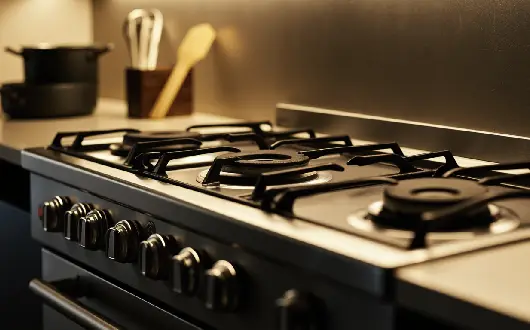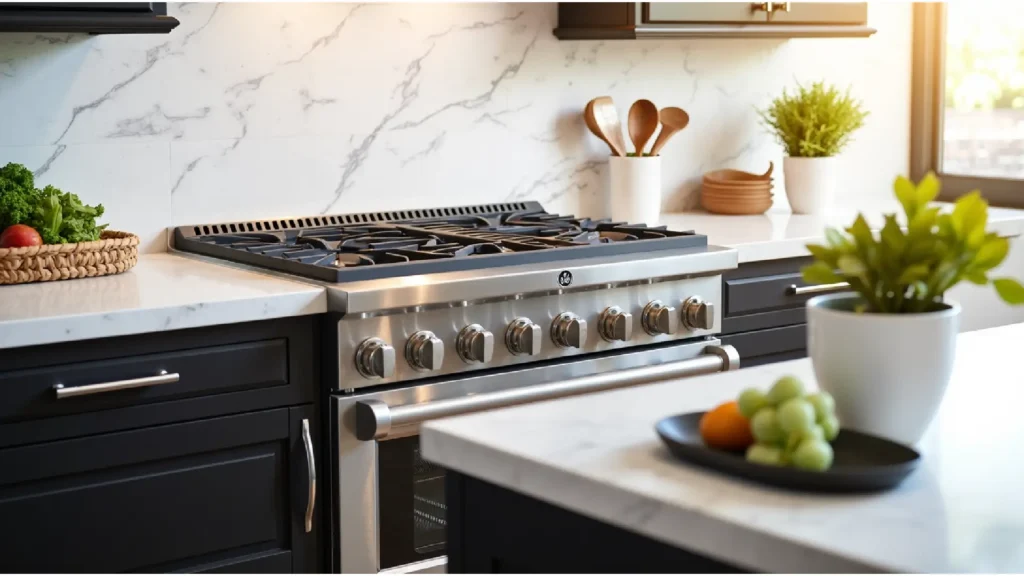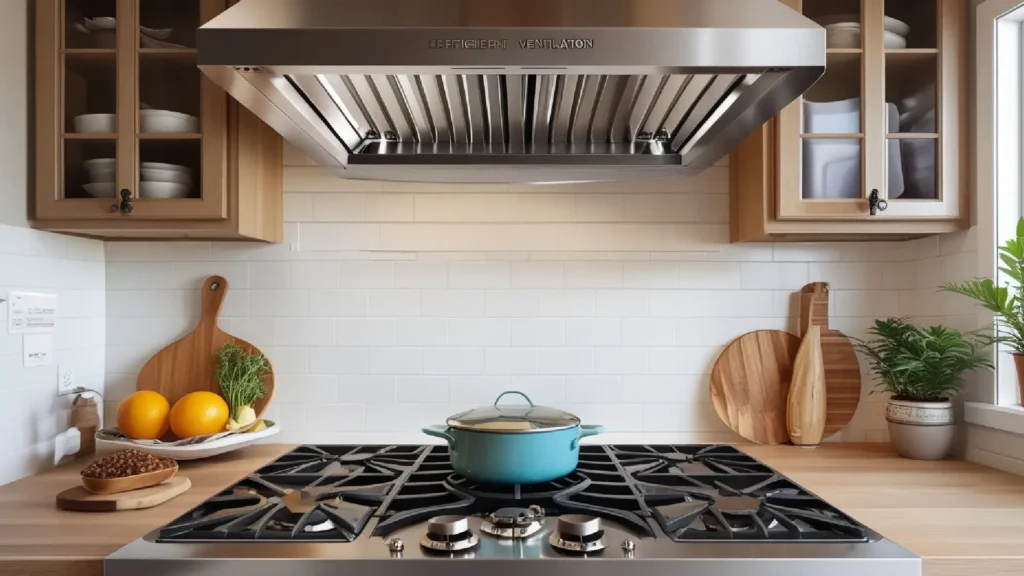
Efficient Ventilation: Gas Cooktop with Downdraft Ventilation System
You know how cooking can sometimes turn your kitchen into a mini sauna? That’s where proper ventilation comes in. It’s not just about keeping the air fresh; it’s about creating a safe and comfortable cooking environment.
When you’re sautéing onions or frying bacon, the last thing you want is to be overwhelmed by smoke or lingering odors. Good ventilation helps to remove these unwanted elements, making your kitchen a more pleasant place to whip up your favorite meals. On top of that, proper ventilation can actually improve your health.
Cooking releases various pollutants, including carbon monoxide and volatile organic compounds (VOCs). If these aren’t vented out, they can accumulate and lead to respiratory issues or other health problems over time. So, investing in a good ventilation system isn’t just about comfort; it’s about protecting your well-being.
Plus, it can help keep your kitchen cleaner by reducing grease buildup on surfaces. Who doesn’t want that?
Key Takeaways
- Proper ventilation in the kitchen is crucial for maintaining air quality and removing cooking odors and pollutants.
- A gas cooktop with downdraft ventilation system offers benefits such as space-saving design, efficient smoke and odor removal, and easy cleaning.
- A downdraft ventilation system works by drawing smoke and odors downward and expelling them outside or filtering them through a charcoal filter.
- When choosing a gas cooktop with downdraft ventilation system, consider factors such as size, power, noise level, and installation requirements.
- Installation and maintenance of a gas cooktop with downdraft ventilation system should be done by a professional to ensure safety and optimal performance.
Understanding the Benefits of a Gas Cooktop with Downdraft Ventilation System
Here’s the rewritten text with 3-4 Benefits of Gas Cooktops with Downdraft Systems Gas cooktops with downdraft systems offer a unique combination of cooking power and effective ventilation. Unlike traditional overhead hoods, downdraft system pulls smoke and odors down and out of the kitchen at the source, allowing you to cook without worrying about lingering smells. ### Aesthetically Pleasing Design Downdraft systems can be more visually appealing than bulky hoods, making them a great option for those who value a sleek kitchen look. You can enjoy the benefits of gas cooking, including instant heat and precise temperature control, while maintaining a clean and modern kitchen design. ### Easy Cleaning and Maintenance Gas cooktops with downdraft systems are often easier to clean, with fewer nooks and crannies for grease to accumulate in. This means less time spent on cleaning and more time enjoying your kitchen.
How a Downdraft Ventilation System Works
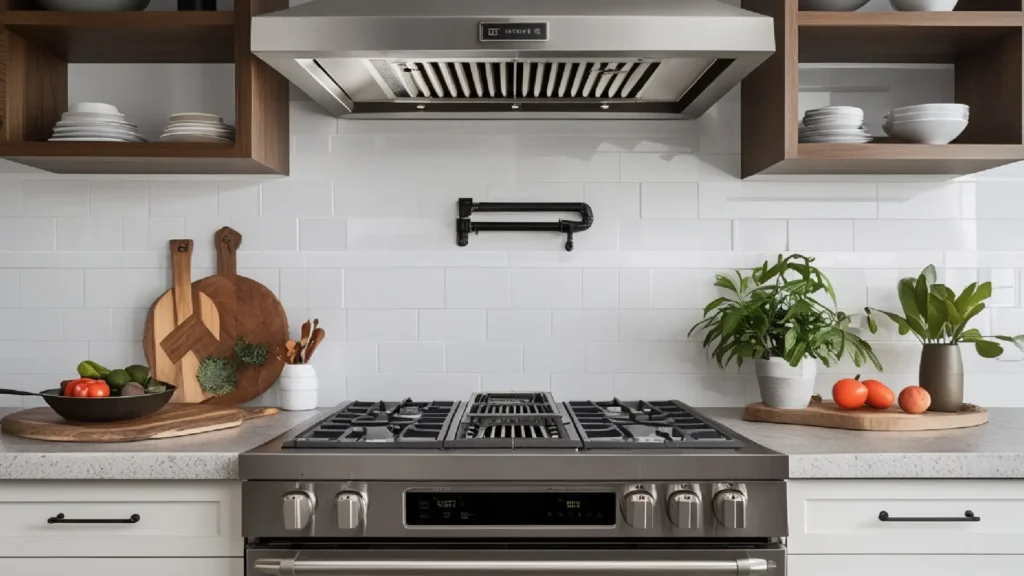
So, how does this downdraft system actually work? It’s pretty straightforward. When you turn on your cooktop, the downdraft fan activates and pulls air down through vents located right behind or beside the burners.
This air then travels through filters before being expelled outside or recirculated back into the kitchen. The design is smart because it captures smoke and steam right where they’re generated, rather than letting them rise and spread throughout the room. To be honest, one of the coolest things about downdraft systems is their versatility.
They can be installed in various configurations, whether you have an island cooktop or a traditional setup against a wall. This flexibility means you can choose a layout that works best for your space without compromising on ventilation efficiency. Just imagine cooking up a storm while keeping your kitchen fresh and inviting!
Factors to Consider When Choosing a Gas Cooktop with Downdraft Ventilation System
| Factor | Description |
|---|---|
| Cooktop Size | Consider the size of the cooktop that will fit your kitchen space and cooking needs. |
| BTU Output | Check the British Thermal Units (BTU) output of the cooktop to ensure it meets your cooking requirements. |
| Downdraft System Power | Look for the power of the downdraft system to ensure it effectively removes cooking odors and smoke. |
| Noise Level | Consider the noise level of the downdraft system to ensure it operates quietly. |
| Installation Requirements | Check the installation requirements to ensure it can be easily installed in your kitchen. |
| Price | Consider the cost of the gas cooktop with downdraft ventilation system and compare it with your budget. |
When you’re on the hunt for a gas cooktop with a downdraft system, there are several factors to keep in mind. First off, think about the size of your kitchen and how much cooking you do. If you’re an avid home chef who loves hosting dinner parties, you might want a larger cooktop with multiple burners.
On the other hand, if you’re more of a casual cook, a smaller model could suffice. Another important consideration is the power of the downdraft fan itself. Not all systems are created equal!
Look for one with adjustable speeds so you can customize the airflow based on what you’re cooking. For instance, frying fish might require more suction than simmering a sauce. Also, check out the noise level; some fans can be surprisingly loud, which might be a dealbreaker if you enjoy chatting while cooking.
Installation and Maintenance of a Gas Cooktop with Downdraft Ventilation System
Installing a gas cooktop with a downdraft system isn’t exactly a DIY project unless you’re super handy. It usually requires professional installation to ensure everything is set up safely and correctly. You’ll need to consider gas line connections and electrical requirements for the fan, which can complicate things if you’re not familiar with home improvement work.
So, don’t hesitate to call in an expert if you’re unsure. Once it’s installed, maintenance is key to keeping everything running smoothly. Regularly check and clean the filters to ensure optimal performance; clogged filters can reduce airflow and efficiency.
Depending on how often you cook, you might need to clean them every few months or so. Also, don’t forget to wipe down the cooktop surface regularly to prevent grease buildup—trust me, it makes a difference!
Tips for Maximizing the Efficiency of a Downdraft Ventilation System
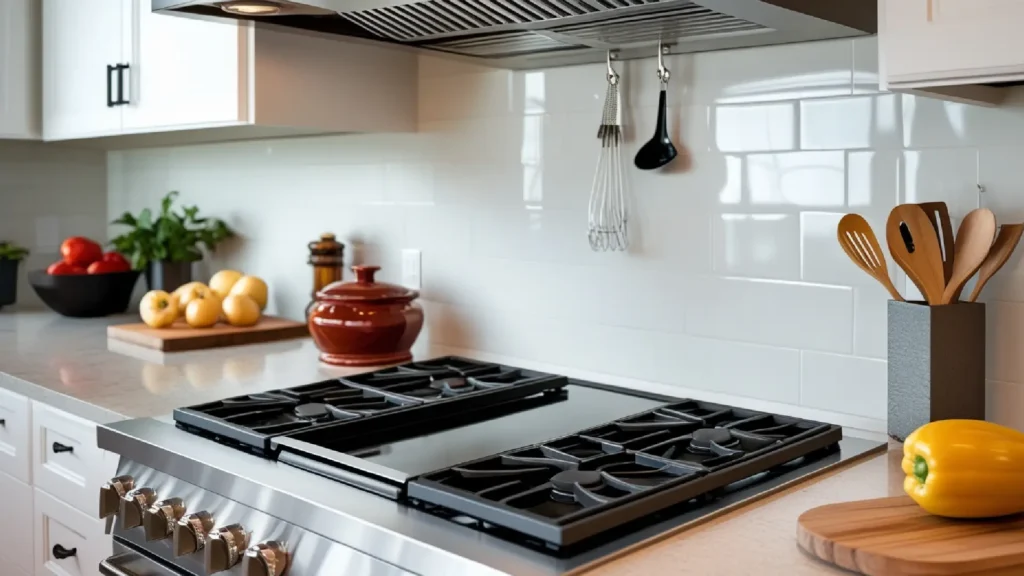
To get the most out of your downdraft ventilation system, there are some simple tips you can follow. First off, always turn on the fan before you start cooking. This way, it can start pulling away any smoke or odors right from the get-go.
It might seem like a small thing, but it really helps keep your kitchen air fresh. Another tip is to use pots and pans that fit well over the burners. If they’re too small or too large, they can create more steam and smoke than necessary, making your downdraft system work harder than it needs to.
Also, try to keep lids on pots when possible; this not only helps with cooking but also minimizes steam escaping into the air. Little adjustments like these can really enhance how well your system performs.
Comparing Gas Cooktops with Downdraft Systems to Other Ventilation Options
You might be wondering how gas cooktops with downdraft systems stack up against other ventilation options like traditional range hoods or even wall-mounted hoods. Well, each has its pros and cons! Traditional hoods are great for capturing smoke and odors but can take up valuable overhead space and may not fit every kitchen design.
On the flip side, downdraft systems are more discreet and can be integrated into various layouts without sacrificing style. However, they might not be as powerful as some high-end range hoods when it comes to heavy-duty cooking tasks like frying or grilling. So if you’re someone who cooks frequently at high temperatures, it’s worth considering how much ventilation power you really need.
The Future of Kitchen Ventilation: Innovations in Downdraft Systems
Looking ahead, it’s exciting to think about what innovations might come in downdraft systems! With technology advancing so quickly, we could see features like smart sensors that automatically adjust fan speed based on cooking conditions or even built-in air quality monitors that alert you when it’s time to ventilate more aggressively. What’s also interesting is the potential for more eco-friendly options in kitchen ventilation.
As sustainability becomes increasingly important in home design, we might see downdraft systems that use less energy or incorporate renewable materials in their construction. It’s an exciting time for kitchen technology, and I can’t wait to see what’s next! In conclusion, investing in proper ventilation especially through a gas cooktop with a downdraft system can significantly enhance your cooking experience while keeping your kitchen safe and stylish.
Whether you’re an occasional cook or someone who spends hours whipping up gourmet meals, understanding these systems will help you make informed choices for your home. So go ahead and explore your options; your future self will thank you!
If you are considering purchasing a gas cooktop with a downdraft ventilation system, you may also be interested in learning about the benefits of using a griddle on a Bosch gas cooktop. A griddle can provide additional cooking options and versatility to your kitchen setup. Check out this article on griddle for Bosch gas cooktop to explore how this accessory can enhance your cooking experience.
FAQs
What is a gas cooktop with downdraft ventilation system?
A gas cooktop with downdraft ventilation system is a cooking appliance that combines a gas-powered cooktop with a built-in downdraft ventilation system. This system is designed to efficiently remove smoke, steam, and cooking odors from the cooking surface, eliminating the need for a separate range hood.
How does a downdraft ventilation system work?
A downdraft ventilation system works by drawing cooking fumes and odors downward through a vent located near the cooking surface. The vent is typically located behind or to the side of the cooktop and can be raised when in use and lowered when not in use. The fumes are then directed outside the home through a duct or filtered and recirculated back into the kitchen.
What are the benefits of a gas cooktop with downdraft ventilation system?
Some benefits of a gas cooktop with downdraft ventilation system include space-saving design, as it eliminates the need for a separate range hood, and improved aesthetics in the kitchen. Additionally, the downdraft ventilation system can be more effective at capturing cooking fumes and odors compared to traditional range hoods.
Are there any drawbacks to using a gas cooktop with downdraft ventilation system?
One potential drawback of a gas cooktop with downdraft ventilation system is that it may not be as effective at capturing cooking fumes and odors as a traditional range hood, especially when cooking with high heat or frying. Additionally, installation and maintenance of the downdraft system may be more complex compared to a standard range hood.
What should I consider when choosing a gas cooktop with downdraft ventilation system?
When choosing a gas cooktop with downdraft ventilation system, consider the size and power of the cooktop, the effectiveness of the downdraft system at capturing cooking fumes, the ease of installation and maintenance, and the overall design and aesthetics of the appliance. It’s also important to ensure that the ventilation system meets local building codes and regulations.

